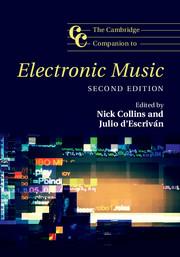Illustrations and Figures
1.2Percy Grainger’s Kangaroo Pouch Machine (courtesy of The Percy Grainger Society/Estate)
1.3Le Corbusier, Iannis Xenakis, Edgard Varèse: Philips Pavilion, 1958
3.1Live performance of Speaker Swinging at the Music Gallery, Toronto, 1987
5.1Michel Waisvisz performs with The Hands (photo: Carla van Tijn)
8.1The Wilmington based Tel-musici Company, from the 18 December 1909 issue of Telephony
8.2Flyer by Rich Gold for the network ensemble The League from 1978, showing the different types of musical data exchange
8.3Adapted from Shannon’s ‘schematic diagram of a general communication system’ (Shannon 1948)
8.4The network music ensemble The Hub, 1989 (top photo: Jim Block) and 2006 (bottom photo: Chianan Yen)
10.1A simple analysis–transformation–synthesis representation based on spectral modelling
10.3The exciter–resonator approach to physical modelling synthesis
12.1Salinity Sampler Sequencer, Owl Project, 2012 (photo by Jill Tate)
12.2Original poster for the Soundwalking radio show of Hildegard Westerkamp (1978/79)
13.1Jukka Hautamäki’s live set up, Madame Claude, Berlin, August 2012
13.2A piece for one, two and three Sudophones (2010) by Visa Kuoppala
15.1The first 21 seconds of Paul Lansky’s Mild und leise (1973) in a time domain plot
15.2Music notation corresponding to the sonic material of Figure 15.1
15.3Frequency domain snapshot of the first sound object of Mild und leise
15.4Spectrogram of the left channel of the first 21 seconds of Mild und leise
15.5The opening of Radiohead’s Idioteque (2000) overlaid with Mild und leise in digital audio workstation software
15.6Spectrogram created in Sonic Visualiser software for the Source recording of Alvin Lucier’s I am sitting in a room (1970)

